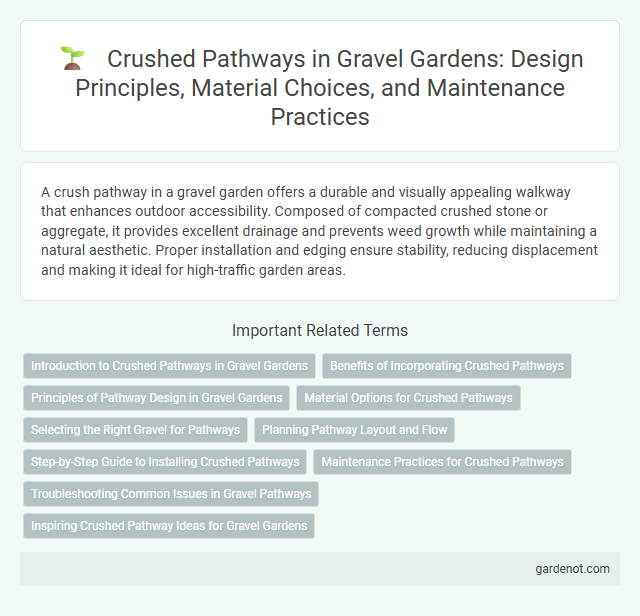A crush pathway in a gravel garden offers a durable and visually appealing walkway that enhances outdoor accessibility. Composed of compacted crushed stone or aggregate, it provides excellent drainage and prevents weed growth while maintaining a natural aesthetic. Proper installation and edging ensure stability, reducing displacement and making it ideal for high-traffic garden areas.
Introduction to Crushed Pathways in Gravel Gardens
Crushed pathways in gravel gardens offer exceptional drainage and durability, making them ideal for high-traffic areas. The use of finely crushed stone creates a stable, compact surface that resists erosion while enhancing garden aesthetics. Selecting appropriate materials such as decomposed granite, limestone, or granite chips ensures longevity and low maintenance for these functional garden pathways.
Benefits of Incorporating Crushed Pathways
Crushed pathways improve garden drainage by allowing water to permeate the surface, reducing puddles and soil erosion. Their porous texture offers natural slip resistance, enhancing safety while maintaining an aesthetically pleasing, rustic look. Using crushed stone pathways promotes sustainability by utilizing recyclable materials and minimizing maintenance compared to paved alternatives.
Principles of Pathway Design in Gravel Gardens
Crush pathways in gravel gardens prioritize permeability, stability, and aesthetic harmony by using compacted gravel layers that allow water infiltration while ensuring firm footing. The design incorporates proper base preparation with crushed stone to prevent shifting and erosion, maintaining long-term durability. Integrating edging materials and selecting gravel sizes contribute to defining clear, visually appealing routes that complement garden layouts.
Material Options for Crushed Pathways
Crushed pathways in gravel gardens offer diverse material options such as pea gravel, decomposed granite, and crushed stone, each providing unique textures and drainage capabilities. Pea gravel creates a smooth surface ideal for walking, while decomposed granite compacts well to form a firm, stable path that resists erosion. Crushed stone, available in various sizes and colors, enhances aesthetic appeal and improves longevity for garden pathways.
Selecting the Right Gravel for Pathways
Selecting the right gravel for pathways involves considering size, texture, and durability to ensure long-lasting stability and comfort underfoot. Opt for angular gravel, such as crushed stone or granite, which locks together better than rounded pebbles, providing a firm surface for walkways. Proper gravel depth, typically 2 to 3 inches above a compacted base, enhances drainage and prevents displacement, making it ideal for gravel garden pathways.
Planning Pathway Layout and Flow
Careful planning of a gravel garden pathway layout enhances both aesthetics and functionality by ensuring smooth flow and accessibility. Position pathways to connect key garden features while maintaining natural curves that guide visitors through the space. Consider soil drainage and compacted base preparation to support long-term durability and prevent uneven surfaces.
Step-by-Step Guide to Installing Crushed Pathways
Creating a crushed pathway in a gravel garden begins with marking the desired path and removing existing grass or soil to a depth of 4 to 6 inches. Next, lay landscape fabric to prevent weed growth and pour a 2-3 inch base layer of crushed stone, compacting it firmly for stability. Finish by spreading a top layer of smaller crushed gravel, carefully leveling and compacting it to form a smooth, durable walking surface.
Maintenance Practices for Crushed Pathways
Crushed pathways require regular upkeep to maintain their stability and appearance, including periodic raking and replenishing of gravel to prevent displacement and erosion. Proper edging installation helps contain the gravel and reduce weed growth, minimizing maintenance efforts. Applying a weed barrier fabric beneath the gravel significantly reduces invasive plant growth, preserving pathway integrity and reducing upkeep time.
Troubleshooting Common Issues in Gravel Pathways
Crush pathways often face drainage problems that cause water pooling and erosion, leading to uneven surfaces and potential trip hazards. To address these issues, ensure proper base preparation with a compacted subbase and install edge restraints to maintain gravel containment. Regularly replenishing gravel and leveling the surface prevents rutting and promotes effective water runoff.
Inspiring Crushed Pathway Ideas for Gravel Gardens
Crush pathways offer a versatile and attractive solution for gravel gardens, combining durability with visual appeal. Incorporating crushed stone with natural edging materials like timber or steel enhances both structure and aesthetics, ensuring pathways remain clear and defined. Using varied gravel sizes and colors can create unique textures and patterns, transforming functional walkways into inspiring garden features.
Crush pathway Infographic

 gardenot.com
gardenot.com